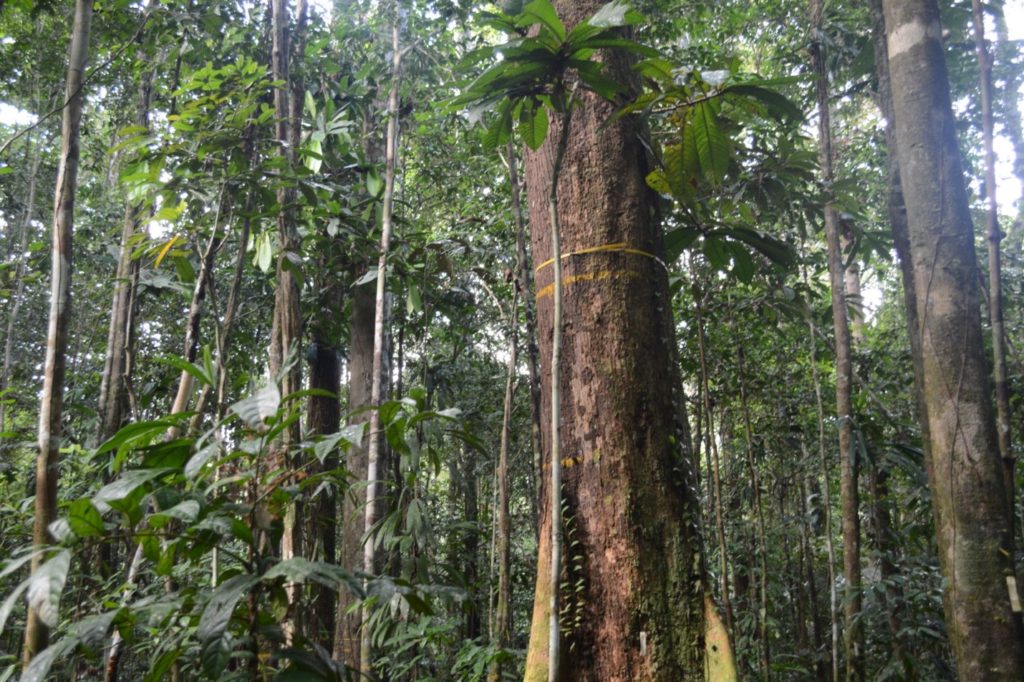ForestGEO scientists measured branch, leaf, and stomatal traits from one thousand trees to explore the sources of trait variability and dynamics among and within Amazon tree species.
The Science
Previous work in Amazon forests has shown significant variation in both tree species distribution and drought-induced tree mortality across small ridges and valleys. Forest ecologists measured 18 branch, leaf, and stomatal traits on 1,077 trees of 72 dominant species to identify the underlying functional traits driving such changes across topography while controlling for a highly documented source of trait variability within species—tree size. Researchers found large trait variability across trees within species (i.e., intraspecific) that was related to trees’ topographic location for leaf traits and tree size for branch and stomatal traits.
The Impact
This study demonstrates the importance of accounting for intraspecific trait variation when testing trait-environment relationships and suggests tree size as a critical source of variability to be included in mechanistic models aiming to predict forest dynamics. The next steps include quantifying physiological traits, functional rooting depths, and water table dynamics to comprehensively understand trees’ vulnerability to climatic drivers (e.g., droughts) and their implications for forest composition and ecosystem services.
Summary
Tropical forest responses to variation in water availability, which are critical for understanding and predicting the effects of climate change, depend on trait variation among trees. ForestGEO scientists quantified interspecific (among species) and intraspecific (across trees within species) variation in 18 branch, leaf and stomatal traits for 72 dominant tree species along a local topographic gradient in an aseasonal Amazon terra firme forest. They used these sampling design to test trait relationships with tree size, elevation, and species’ topographic associations as well as trait correlations. Intraspecific trait variation was substantial and exceeded interspecific variation in 10 of 18 traits. For leaf acquisition traits, intraspecific variation was mainly related to tree topographic elevation, while most of the variation in branch, leaf and stomatal traits was related to tree size. Interspecific variation showed no clear relationships with species’ habitat association. Although trait correlations and coordinations were generally maintained among trees and among species, bivariate relationships varied among trees within species, across habitat association classes and across tree size classes. These results demonstrate the magnitude and importance of intraspecific trait variation in tropical trees, especially as related to tree size. Furthermore, these results indicate that previous findings relating interspecific variation with topographic association in seasonal forests do not necessarily generalize to aseasonal forests.

Contact: Daniel Zuleta, Forest Global Earth Observatory, Smithsonian Tropical Research Institute (dfzuleta@gmail.com)
Funding
D. Zuleta was supported by the National Doctoral Scholarship COLCIENCIAS-Colombia (647, 2015-II), the Smithsonian Tropical Research Institute Short-Term Fellowships and the Next Generation Ecosystem Experiments-Tropics, funded by the US Department of Energy, Office of Science, Office of Biological and Environmental Research (https://ngee-tropics.lbl.gov/). Data collection was supported by the Forest Global Earth Observatory (ForestGEO) of the Smithsonian Institution and Universidad Nacional de Colombia.
Publications
Zuleta, D., Muller-Landau, H.C., Duque, A., Caro, N., Cardenas, D., Castaño, N., León-Peláez, J.D., and Feeley, K.J. “Interspecific and intraspecific variation of tree branch, leaf and stomatal traits in relation to topography in an aseasonal Amazon forest.” Functional Ecology 36, 2955– 2968 (2022). [DOI: 10.1111/1365-2435.14199]